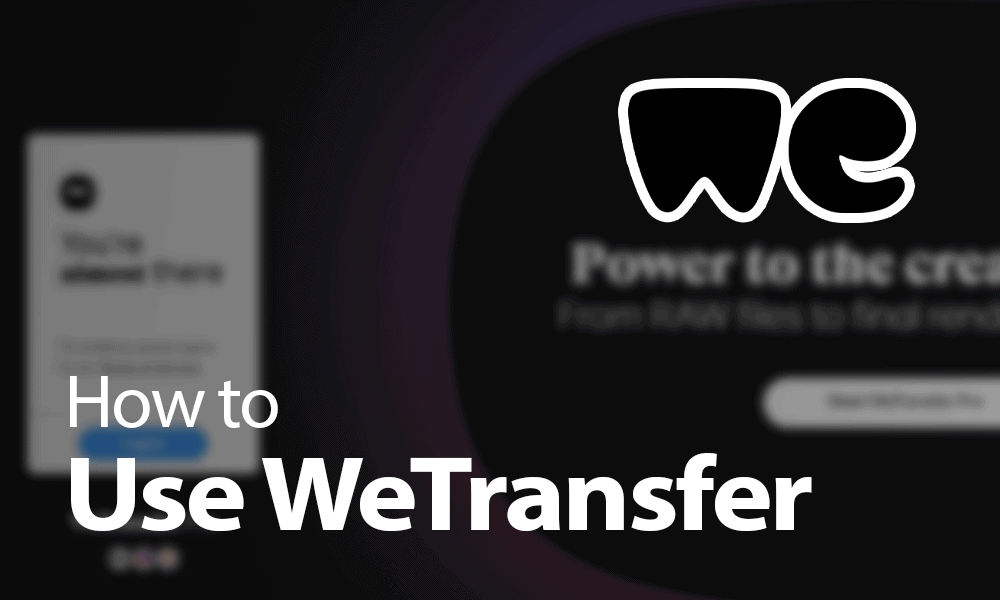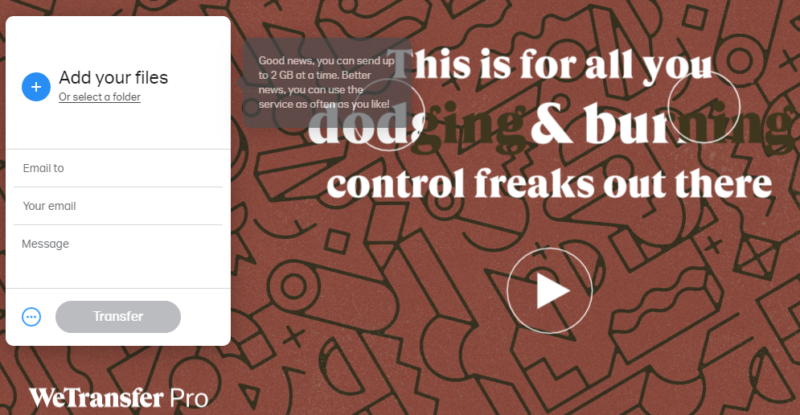
How to Use WeTransfer in 2024: Easy Steps to Send Large Files Search
Cloudwards.net may earn a small commission from some purchases made through our site. However, any earnings do not affect how we review services. Learn more about our editorial integrity and research process.
Why you can trust us
- 407 Cloud Software Products and Services Tested
- 3056 Annual Software Speed Tests
- 2400 plus Hours Usability Testing
Our team of experts thoroughly test each service, evaluating it for features, usability, security, value for money and more. Learn more about how we conduct our testing.
Key Takeaways: How to Use WeTransfer
- Go to wetransfer.com and click the plus sign to upload a file.
- Enter your email address and the recipients email address, as well as a title and a message.
- Click Transfer and verify your email address using the code.
Facts & Expert Analysis:
- WeTransfer is an incredibly easy-to-use file transfer service that lets you send files up to 2GB on the free version and up to 20GB on its paid version, called WeTransfer Pro.
- This step-by-step guide will show you everything you need to do in order to successfully use WeTransfer.
- By following these instructions, you will learn how to send large files for free using WeTransfer.
How to Use WeTransfer Video Guide:

WeTransfer is one of the easiest and most reliable ways to send large files via the internet. To make this process even easier and to show you how to use WeTransfer, we’ve made this step-by-step guide that will take you through the entire process, from start to finish.
Please note that this was done using the free service, without setting up a free account or subscribing to WeTransfer’s paid plan — WeTransfer Pro — but the process is the same either way.
Meet the experts
Learn more about our editorial team and our research process.
How to Use WeTransfer (Free): Step-by-Step Guide
Since it is a freemium service, you don’t need to make a WeTransfer account in order to start using it. You can both upload and send files as well as receive and download them without signing up for this cloud service. And now — on to the guide itself.
How Do I Transfer Files Using WeTransfer?
Thanks to its great interface, transferring files with WeTransfer is incredibly easy to use.
- Upload Your File
Since you don’t need to sign up, you can just go to the home page and start the transfer process. On the left-hand side of the home page, there is an option to add files. You can drag and drop your file right into the browser to upload.

You can add up to 2GB of files on WeTransfer’s free version, and up to 20GB on the WeTransfer Pro.
- Enter the Recipient’s Address and Send Your File
Next, enter the recipient’s email address, your email address and an optional message. As soon as the file gets uploaded, you can send it to the addressee.

- Send a Download Link
Alternatively, you can get a download link from WeTransfer. Simply click on the three dots icon, and you’ll see the option to get a transfer link.

- Enter Your WeTransfer Code
Before sending your files, WeTransfer first needs to verify your email address. You will receive a six-digit code via email that you need to enter. This code is active for 60 minutes. However, if you don’t manage to input it in time, you can always request a new code. Of course, if you create a WeTransfer account, you will be able to skip this step.

You’ll receive two emails after sending data through WeTransfer via the email option. The first email message includes a confirmation that your file transfer has been sent, and the second one comes when the recipient downloads the submitted file. The file(s) are available for download for seven days before being permanently deleted.
With the file link option, there are no visibility features available. However, if someone has the link, they can download and access your file — and you’ll be none the wiser. The only way out is to password-protect the file (which you can only do with WeTransfer Pro).
Downloading Files From WeTransfer
You can receive a file from WeTransfer either via email or by using a download link. In both cases, you’ll be redirected to WeTransfer’s recipient page, which sports a big “download” button. All you have to do is click that button, and you’ll begin downloading the file. There’s nothing else to do.

The file download link is active for seven days by default. However, if the user in question has a WeTransfer Pro account, they can set a custom time limit or even choose to have the files available indefinitely without being deleted.
In any case, you’ll see the file’s deletion date on the download page. WeTransfer claims that data gets deleted from the company’s servers on the file’s expiration date, and there is absolutely no way you can retrieve such files.
Final Thoughts: Using WeTransfer
WeTransfer’s simplicity is undoubtedly its biggest strength. In just a few easy steps, even people who don’t have much tech experience can quickly figure out how to use it to share PDF files and other types of media. We hope that this step-by-step guide has demonstrated just how uncomplicated it is to use WeTransfer.
Are you a WeTransfer user? How long have you been using WeTransfer? Are you happy with this file transfer service, or are you looking to switch to a WeTransfer alternative? Tell us in the comments below. As always, thank you for reading.
FAQ
-
WeTransfer is a file transfer service that allows you to send large files over the internet. Using WeTransfer is very easy — all you need to do is upload your files, enter your email address, the email of the recipient and the WeTransfer verification code and your files will be sent. The recipient will receive an email message with a link that will allow them to download the files you’ve sent.
-
Anyone can use WeTransfer for free; however, there are some limitations. The total size of your files cannot exceed 2GB and the files will only be available for download for seven days before they get deleted. On WeTransfer’s paid plan, the WeTransfer Pro, this transfer file size limit increases to 20GB and you can customize when your files will get deleted.
-
Sending a video over WeTransfer is the same as sending any other file. Since video files can be very large, you may need to compress the video into smaller ZIP files to get around WeTransfer’s file size limit, but other than that, the process is identical.
-
WeTransfer has been banned in India since May 18, 2020. The Indian Department of Telecommunications (DoT) issued a directive that cited “public interest as it was being misused” as the reason for this decision. Besides WeTransfer, some 4,000 websites have also been made inaccessible in India. In order to get around this ban, you will need to use a VPN.
WeTransfer is a file transfer service that allows you to send large files over the internet. Using WeTransfer is very easy — all you need to do is upload your files, enter your email address, the email of the recipient and the WeTransfer verification code and your files will be sent. The recipient will receive an email message with a link that will allow them to download the files youu2019ve sent.n”}},{“@type”:”Question”,”name”:”How Do I Use WeTransfer for Free?”,”acceptedAnswer”:{“@type”:”Answer”,”text”:”
Anyone can use WeTransfer for free; however, there are some limitations. The total size of your files cannot exceed 2GB and the files will only be available for download for seven days before they get deleted. On WeTransferu2019s paid plan, the WeTransfer Pro, this transfer file size limit increases to 20GB and you can customize when your files will get deleted.n”}},{“@type”:”Question”,”name”:”How Do I Send a Video on WeTransfer?”,”acceptedAnswer”:{“@type”:”Answer”,”text”:”
Sending a video over WeTransfer is the same as sending any other file. Since video files can be very large, you may need to compress the video into smaller ZIP files to get around WeTransferu2019s file size limit, but other than that, the process is identical.n”}},{“@type”:”Question”,”name”:”Why Is WeTransfer Banned in India?”,”acceptedAnswer”:{“@type”:”Answer”,”text”:”
WeTransfer has been banned in India since May 18, 2020. The Indian Department of Telecommunications (DoT) issued a directive that cited u201cpublic interest as it was being misusedu201d as the reason for this decision. Besides WeTransfer, some 4,000 websites have also been made inaccessible in India. In order to get around this ban, you will need to use a VPN.n”}}]}]]>
Let us know if you liked the post. That’s the only way we can improve.
Also interesting
Last published on Cloudwards:
Jackie is the chief editor of Cloudwards.net. After earning her bachelor’s degree in journalism from the University of New Hampshire, she has held various editing roles with international news organizations, annual magazine publications, book publishing and more. When she’s not editing Cloudwards.net articles, she’s either putting pen to paper with creative nonfiction writing, going for an ocean swim or planning her next travel adventure.
Last published on Cloudwards:





